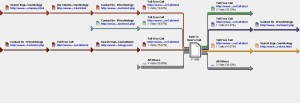Don’t Forget Off-line Conversions
Over the past five to eight years, Search Engine Marketing (“SEM”) professionals have finally woken up to the reality that the goal of their campaigns, be it search engine optimization (“SEO”), pay per click (“ppc”) like Google Adwords or any other effort is not about driving the maximum number of eyeballs to a web site; it’s about conversions. Yes, the goal must be to drive quality traffic that converts on the site.
With the advances in web analytic products like WebTrends, SiteCatalyst and Google Analytics (just to name a few of the more popular tools); the ability to assign conversions to specific marketing efforts has improved immensely and allow a the Search Engine Marketer and more importantly their clients the ability to properly evaluate their efforts. Through this effort campaigns can be more effectively optimized to maximize the return on the investments (“ROI”).
Yet one question that most organizations get wrong is “What is a conversion?”. Many organization understand that when it comes to an e-commerce site on-line sales are a conversion, other sites where the goals may be subscription registrations or trial downloads understand and know how to track these as conversions. Yet websites may have many more possible conversion points, some of which are easier to measure than others.
The hardest ones to measure are off-line conversions. These are conversions that happen not on the website itself, but through a different commerce channel. How do you account for the person who came to your site, poked around found what they wanted at a price they wanted to pay, but instead of buying it online stopped at a retail outlet on their way home from work to purchase it? Do you give the SEM campaign credit for a portion of in-store sales? Most organizations do not, despite their very real impact.
What do you do when the customer calls a number on the website to place the order over the phone? How do you measure or account for a customer’s call during a website visit about a specific question that leads them to completing their purchase on-line? If you didn’t answer the call or didn’t answer their question properly the customer may have not completed their purchase.
For companies dealing with the issue of call attribution there are now products on the market that provide call tracking information and even allow attribution to specific marketing events including SEO and PPC right down to specific keywords. What is missing from most of these call tracking analytics tools is the ability to integrate them into your existing web analytics tool.
Mongoose Metrics, a firm providing call tracking solutions, has even taken on the issue of integrating call tracking analytics with existing web analytics tools. The first integration was completed early in November with the integration into WebTrends. They are currently finalizing the integration with Ominture Site Catalyst and Google Analytics which should be completed by the end of the year.
So what will this mean to you if you start to using the call tracking software from Mongoose and integrated into your web analytics tools? In a nutshell, it is everything. By integrating when the call takes place and attributing it to specific marketing campaigns, you will be able to see not only which campaigns are driving on-site conversions but which ones are generating phone calls. By evaluating the nature of these calls (listening to the recorded calls), you can find out typical questions or issues and then use this information to improve landing pages and/or web site content. One of my favorite things to do is a path analysis to and from the call. By evaluating the paths, I can determine if there is a reoccurring pattern in user behavior that must be addressed. Or perhaps I just want to see what happens after each call; do they simply leave the site, or do they continue on their journey and complete their on-site conversion.

Path Analysis to and From Call
One trick I like to do is to calculate an average value to each phone call and attribute this value to each call received as part of the revenue generated by different campaigns. This provides another comparison point which can be very valuable. To improve the accuracy of the value each phone call Mongoose has just developed a new feature that will let the operator (the person who answered the call) to input the value of the call so that you don’t have to use a fixed value. Of course the down side of this is that you must take the time to enter the value immediately after the call to avoid issues with data entering your web analytics stream out of sequence or not at all.
With a bit of advance configuration, during our tests, we were even able to report on calls generated through social media efforts. This included measuring the number of calls that came from links included in Twitter posts and Facebook status updates. Essentially the potentials for call tracking is limitless.

Call by Marketing Source
By comparing which keyword phrases generate calls, which marketing campaigns generate calls, the nature of calls by campaign and the overall value of these calls to specific marketing efforts, one major hurdle in tracking off-line conversions can be cleared. With this overall increase in viable conversion data in your web analytics tool you now have a more powerful reborn analytics tool which will give you a competitive advantage when implemented and interpreted correctly.
Alan K’necht is the President of K’nechtology Inc. a firm specializing in web analytics, SEO and PPC campaign management and frequent speaker at web marketing conferences throughout the world. Follow Alan on Twitter @aknecht
Sphinn this Post | Share this Post http://bit.ly/5nwiHB








